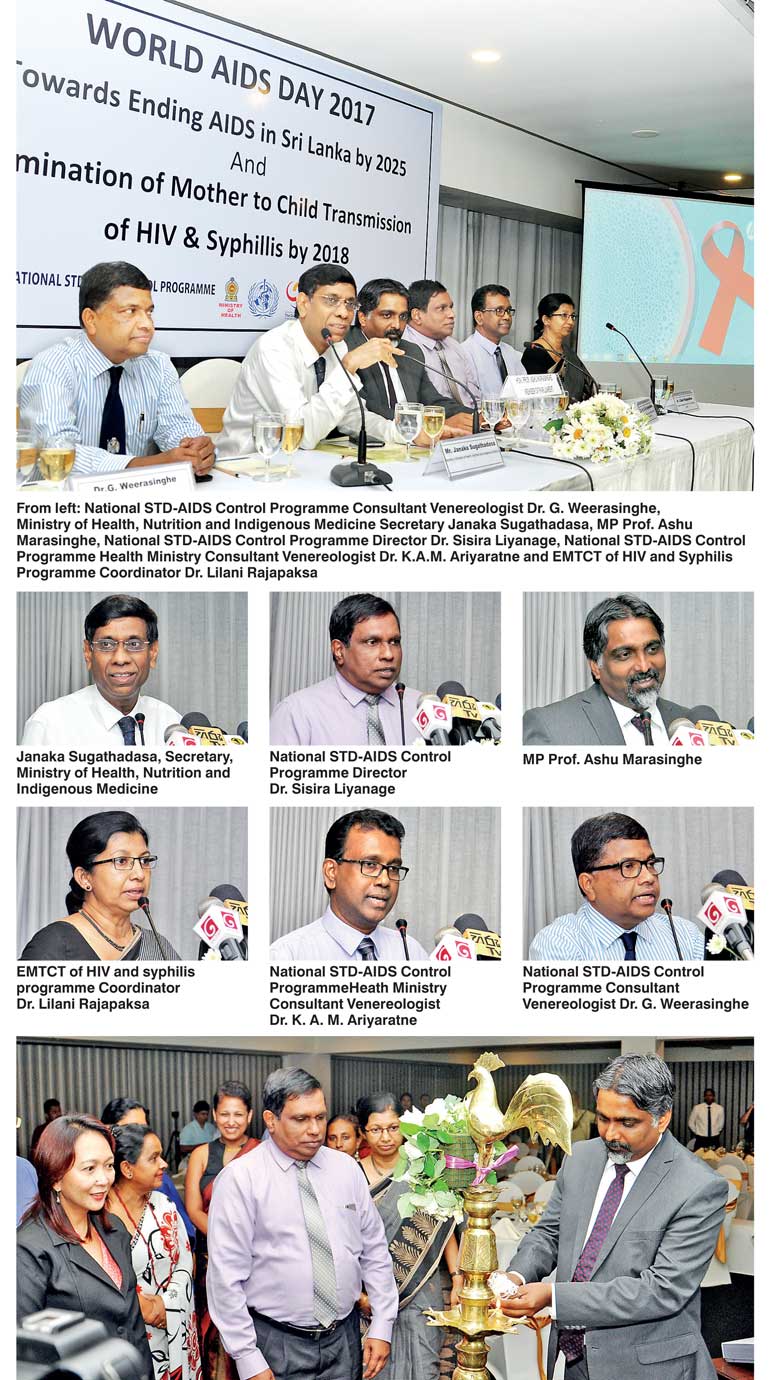Monday Jun 23, 2025
Monday Jun 23, 2025
Thursday, 30 November 2017 00:00 - - {{hitsCtrl.values.hits}}

By Shanika Sriyananda
Sri Lanka, which records a continuous low prevalence rate of HIV/AIDS, targets to end HIV/AIDS seven years before the UN’s target of ending the disease by 2030, a top official of the National STD/AIDS Control Program said.
Compared to other South Asian countries, Sri Lanka maintains a low prevalence rate of 0.03, which means only three people out of 10,000 get infected with HIV/AIDS, he said.
Director of the National STD/AIDS Control Program Dr. Sisira Liyanage addressing the Media Advocacy Program in relation to the World AIDS Day 2017 held in Colombo on Monday said reaching the target to end HIV/AIDS in Sri Lanka by 2025 would not be a difficult task as Sri Lanka had recorded some achievements by reducing the mother-to-child transmission significantly, increasing and encouraging testing facilities for HIV/AIDS and giving Antiretroviral Therapy (ART) free of charge in all Government hospitals.
Sri Lanka agreed with 192 countries to end HIV/AIDS under Goal 3 of the 17 Sustainable Development Goals by 2030.
“Out of estimated 4,000 cases of HIV/AIDS, 2,766 people have been clinically confirmed of living with the disease. The challenge for us to reach our target is to get those who are living with HIV/AIDS but in hiding into the treatment process,” Dr. Liyanage said.
He said that the Government had given priority, facilities and funds for HIV/AIDS prevention. “The World Bank, UNICEF, the Global Fund, the NGOs and private sector support in HIV/AIDS prevention programs. The Government cannot do everything alone and needs the support of all the stakeholders,” he said.
Appreciating the support of the media in HIV/AIDS prevention, he said that the media campaign slogan, which was said earlier that HIV/AIDS was deadly needed to be changed to make people aware that HIV/AIDS was treatable and prolonged life when treated timely and properly.
“We need media support to pass this message to people and get those who are still avoiding testing into the treatment process. When they are given ART drugs their viral load will be normal and they will live long,” Dr. Liyanage said.
He also said that people living with HIV/AIDS were badly stigmatised till the 1990s but with the support of all stakeholders, including media awareness campaigns, it had reduced to a great extent. However, he said that the aim of the National STD/ AIDS Control Program was to reduce social stigma towards HIV/AIDS patients to zero.
“They have the right to live just like all of us. When they are treated they are normal people. It is a responsibility of all people to accept them and help them to recover,” he noted.
According to Dr. Liyanage, when society rejects them, they do not come for testing and treatment as they want to hide, which poses a great risk of spreading the disease.
Government hospitals provide HIV/AIDS testing facilities and ART treatments free of charge in all the STD clinics.
Dr. Liyanage said these factors had resulted in Sri Lanka maintaining a low prevalence rate and to embark on a new target of ending HIV/AIDS by 2025.
“We have only seven years to achieve the target and we request all stakeholders to support us. We are blessed with the top political leadership which is concerned about HIV/AIDS prevention,” he said.
– Pix by Ruwan Walpola
Discover Kapruka, the leading online shopping platform in Sri Lanka, where you can conveniently send Gifts and Flowers to your loved ones for any event including Valentine ’s Day. Explore a wide range of popular Shopping Categories on Kapruka, including Toys, Groceries, Electronics, Birthday Cakes, Fruits, Chocolates, Flower Bouquets, Clothing, Watches, Lingerie, Gift Sets and Jewellery. Also if you’re interested in selling with Kapruka, Partner Central by Kapruka is the best solution to start with. Moreover, through Kapruka Global Shop, you can also enjoy the convenience of purchasing products from renowned platforms like Amazon and eBay and have them delivered to Sri Lanka.
Discover Kapruka, the leading online shopping platform in Sri Lanka, where you can conveniently send Gifts and Flowers to your loved ones for any event including Valentine ’s Day. Explore a wide range of popular Shopping Categories on Kapruka, including Toys, Groceries, Electronics, Birthday Cakes, Fruits, Chocolates, Flower Bouquets, Clothing, Watches, Lingerie, Gift Sets and Jewellery. Also if you’re interested in selling with Kapruka, Partner Central by Kapruka is the best solution to start with. Moreover, through Kapruka Global Shop, you can also enjoy the convenience of purchasing products from renowned platforms like Amazon and eBay and have them delivered to Sri Lanka.